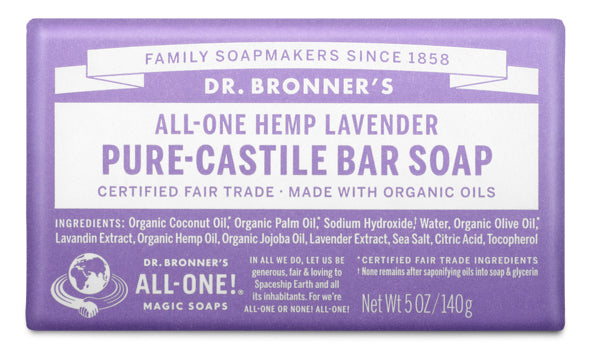Dr. Bronner’s Pure-Castile Bar Soap has all the benefits of its liquid counterpart and even has it beat in some areas, like affordability, packaging, travel ease, and accessibility. Use this bar soap cheat sheet to assist you in utilizing the bar soap effectively and to spark new ideas!
Descargue la hoja de dilución en Español aquí.
Table of Contents
Some of the below dilutions call for the bar soap in grated or “soap cream” form. Here’s how to create these:
-
Grated bar soap: Grate bar soap with a medium-to-fine kitchen grater. Dissolves best in warm to hot water.

-
Soap cream: Dice bar soap into ½-inch cubes. Soak in 4 c. (960 mL) water for 24 hours. Blend in blender on lowest speed to create a foamy gel. Alternatively, grate bar soap and blend with 4 c. (960 mL) warm (not steamy) water in blender on lowest speed.

Body Uses
Hands, Face & Body
Lather Pure-Castile Bar Soap on wet hands or washcloth.
Makeup Removal
Wet face and lather bar soap on to hands. Massage into skin. Rinse.
Hair
Rub wet bar soap into very wet hair. Lather and rinse. Follow with Dr. Bronner’s Citrus Organic Hair Rinse or diluted apple cider vinegar.
Bath
Add 4 Tbsp. (60 mL) grated bar soap or ½ c. (120 mL) soap cream to running warm bath water. (Doesn’t bubble, but still cleans.)
Shaving
Lather bar on area to create creamy foam. Or, cut to fit as a shaving cake in bottom of shaving cup. Whip up lather with wet shaving brush.
Teeth
Cut a portion of bar to dedicate to toothbrushing. Swipe toothbrush on bar and brush to teeth. Rinse.
Foot Bath
Add 1 Tbsp. (15 mL) grated bar soap in a small tub of very warmwater. Swish to dissolve.
Household Uses
Dishes, Handwashing
Rub dishcloth or brush on bar soap. Or, add 2 Tbsp. (30 mL) grated bar soap or ¼ c. (60 mL) soap cream to about 1 ½ gallons (6 L) very warm running water. Swish to dissolve.
Laundry
Recommended in hot and warm water only. Not recommended for HE. Use Dr. Bronner’s Liquid Castile or Sal Suds in cold water and HE.
- Grated bar soap: In a food processor, combine one grated bar of soap with 4 c. (960 mL) baking soda. Pulse to blend. Use ¼-⅓ c. (60-80 mL) per large load.
- Soap cream: Use ½ c. (120 mL) for a large load. Add ½ c. (120mL) baking soda to wash cycle.
For either method, add 1 c. (240 mL) vinegar to the rinse cycle.
Handwashing Delicates
In 1 gallon (4L) cold water, lather bar soap with hands until the water is slightly soapy. Swish garment gently. Let soak 10 minutes. Swish again. Rinse with clean water. Gently press out excess water with a towel. Hang or lay flat to dry.
Mopping (wood, laminate & stone flooring): Add 1 Tbsp. (15 mL) grated bar soap or ¼ c. (60 mL) soap cream to1 gallon (4 L) hot water. Dunk mop and wring thoroughly. On wood and laminate, avoid excess water.
All-Purpose Cleaning Spray
Dissolve ½ c. (120 mL) soap cream in 3 ½ c. (840 mL) warm water. Whisk to blend. For extra antimicrobial, add ¼ tsp. (1.25 mL) tea tree essential oil.
Windows
Dissolve 1 tsp. (5 mL) soap cream in 1 quart (1 L) warm water in a spray bottle. Spray window and squeegee. Follow with spray of club soda or vinegar/water. Wipe dry.
Toilet
Spray toilet bowl thoroughly with All-Purpose Spray (above) with optional ¼ tsp. (1.25 mL) tea tree oil added. Sprinkle baking soda on toilet brush, scrub bowl, let sit 10 minutes, flush.
Other Uses
Fruit & Veggie Wash
Lather bar soap with hands into a bowl of water. Dunk produce and swish. Rinse in clear water.
Dog Washing
Wet dog thoroughly. Massage bar in fur to create good lather. Rinse thoroughly. As with people, avoid soap in eyes and water in ears.
Cleaning Makeup Brushes
Wet makeup brush thoroughly. Lather soap in hands and massage gently through bristles for 10+ seconds. Rinse and air dry.
Ant Spray (Not on Plants)
Dissolve ½ c. (120 mL) soap cream in 3 ½ c. (840 mL) of water.

